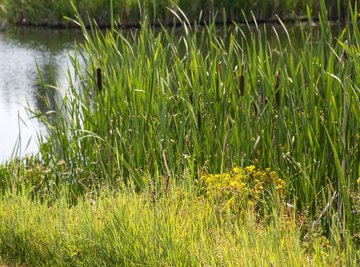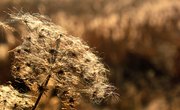
Lakeshores offer valuable habitats for plants and animals. Among the types of plants found around lakes, high grass plants and other tall plants proliferate. Some are true grasses, while others are rushes, sedges and other plants. Both native and invasive species of tall grasses grow around lakes.
TL;DR (Too Long; Didn't Read)
Many types of tall grasses grow around lakes, providing habitat and food for various organisms. Some are true grasses, while others are rushes, sedges, and other plants that are either native or invasive.
Types of Tall Grasses Around Lakes
Many types of tall grasses grow along the shores of lakes. The ear-leaved brome (Bromus latiglumis) grows as high as five feet tall and has nodding seedheads and ear-like flaps on its leaf blades. Prairie cordgrass (Spartina pectinata) is prevalent among tall native grasses in the Midwestern United States. It can grow as high as six feet and turns golden in autumn. Native Americans used its blades for thatching and fuel.
Switchgrass (Panicum virgatum) is another tall wild grass that grows around lakes. Switchgrass forms upright clumps, has gray-green summer and yellow autumn color, and grows as high as six feet. Another tall wild grass around lakes is foxtail barley.
Common reed is an invasive tall wild grass that reaches great heights, sometimes as much as an astounding 15 feet. Common reed grasses have hollow stems and prefer stagnant water areas and full sun. These grasses bear purple flowers in summer. Common reed has been used around the world for basket making and roof thatches. It is thought that this tall grass arrived in North America via ship ballasts.
Lake Plants Resembling Tall Wild Grass
Tall, grasslike plants that are not true grasses can be found alongside lakes, too. The leafless soft-stemmed rush (Juncus effusus) can grow up to three feet tall and has hollow stems. Hardstem bulrushes (Scirpus acutus) are tall marsh grasses that grow in water and emerge as high as eight feet. Common bulrush (Scirpus atrovirens) can reach five feet in height and is one of the prevalent tall native grasses in eastern and central North America.
Sedges are a type of lake grass that are prevalent and varied. Awl-fruited sedge (Carex stipata) has spongy stems and beaked fruit, and it grows up to three feet tall. Fringed sedge (Carex crinite) grows as high as three feet and bears bristles that give it its name. Palm sedges (Carex muskingumensis) grow to about three feet tall and bear tufts at their tips, making them look like little palms. Tussock sedge (Carex stricta) is blue-green and grows in tussocks or mounds; its seedheads reach about three feet tall.
Horsetails, or scouring rushes, are hollow types of tall marsh grasses that resemble long, green straws. Different varieties of horsetails can reach between two feet to five feet tall. They are ancient, seedless plants of the division Pteridophyta, and they grow well around bodies of water or within marshes.
On the other hand, cattails are tall types of lake grass with brown, bulbous flower spikes; hence their name, and some can reach as much as eight feet high. They are edible plants that provide valuable food and shelter for many organisms.
The Importance of Lake Grass
The many types of tall grasses found around lakes serve several important roles. Many provide shelter and shade for animals. They also yield food; for example, all parts of the cattail are edible. Other grasses provide seeds.
Humans also use tall wild grass varieties in numerous ways. Many tall native grasses have been used for thatching roofs, making fuel and weaving baskets. Other grasses provide food. and many types of tall grass can be used for ornamental purposes around ponds, water gardens or lakefront properties. Tall native grasses also help prevent erosion.
Invasive species such as the common reed are unfortunately often rampant. This can alter shorelines, making them denser and not as hospitable to lakeshore wildlife. Great care must be taken when introducing tall grasses around lakes and other water features.
References
About the Author
J. Dianne Dotson is a science writer with a degree in zoology/ecology and evolutionary biology. She spent nine years working in laboratory and clinical research. A lifelong writer, Dianne is also a content manager and science fiction and fantasy novelist. Dianne features science as well as writing topics on her website, jdiannedotson.com.
